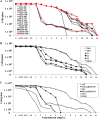"Slow VISA," a novel phenotype of vancomycin resistance, found in vitro in heterogeneous vancomycin-intermediate Staphylococcus aureus strain Mu3
- PMID: 24841271
- PMCID: PMC4135821
- DOI: 10.1128/AAC.02470-13
"Slow VISA," a novel phenotype of vancomycin resistance, found in vitro in heterogeneous vancomycin-intermediate Staphylococcus aureus strain Mu3
Abstract
Heterogeneous vancomycin-intermediate Staphylococcus aureus (hVISA) clinical strain Mu3 spontaneously generates VISA strains at an extremely high frequency (≥1×10(-6)). The generated VISA strains usually grow more slowly than does the parent hVISA strain, but they form colonies on vancomycin-containing agar plates before 48 h of incubation. However, we noticed a curious group of VISA strains, designated "slow VISA" (sVISA), whose colonies appear only after 72 h of incubation. They have extremely prolonged doubling times but have vancomycin MICs of 8 to ∼24 mg/liter when determined after 72 to ∼144 h of incubation. We established strain Mu3-6R-P (6R-P), which has a vancomycin MIC of 16 mg/liter (at 72 h), as a representative sVISA strain. Its cell wall was thickened and autolytic activity was decreased compared to the respective qualities of the parent hVISA strain Mu3. Whole-genome sequencing of 6R-P revealed only one mutation, encoded by rpoB (R512P), which replaced the 512th arginine of the RNA polymerase β-subunit with proline. Its VISA phenotype was unstable, and the strain frequently reverted to hVISA with concomitant losses of pinpoint colony morphology and cell wall thickness and reduced autolytic activity. Sequencing of the rpoB genes of the phenotypic revertant strains revealed mutations affecting the 512th codon, where the proline of 6R-P was replaced with leucine, serine, or histidine. Slow VISA generated in the tissues of an infected patient serves as a temporary shelter for hVISA to survive vancomycin therapy. The sVISA strain spontaneously returns to hVISA when the threat of vancomycin is lifted. The rpoB(R512P) mutation may be regarded as a regulatory mutation that switches the reversible phenotype of sVISA on and off.
Copyright © 2014, American Society for Microbiology. All Rights Reserved.
Figures





Similar articles
-
A mutation of RNA polymerase β' subunit (RpoC) converts heterogeneously vancomycin-intermediate Staphylococcus aureus (hVISA) into "slow VISA".Antimicrob Agents Chemother. 2015 Jul;59(7):4215-25. doi: 10.1128/AAC.00135-15. Epub 2015 May 4. Antimicrob Agents Chemother. 2015. PMID: 25941225 Free PMC article.
-
Mutation of RNA polymerase beta subunit (rpoB) promotes hVISA-to-VISA phenotypic conversion of strain Mu3.Antimicrob Agents Chemother. 2011 Sep;55(9):4188-95. doi: 10.1128/AAC.00398-11. Epub 2011 Jul 11. Antimicrob Agents Chemother. 2011. PMID: 21746940 Free PMC article.
-
Comprehensive identification of mutations responsible for heterogeneous vancomycin-intermediate Staphylococcus aureus (hVISA)-to-VISA conversion in laboratory-generated VISA strains derived from hVISA clinical strain Mu3.Antimicrob Agents Chemother. 2013 Dec;57(12):5843-53. doi: 10.1128/AAC.00425-13. Epub 2013 Sep 9. Antimicrob Agents Chemother. 2013. PMID: 24018261 Free PMC article.
-
Staphylococcus aureus response and adaptation to vancomycin.Adv Microb Physiol. 2024;85:201-258. doi: 10.1016/bs.ampbs.2024.04.006. Epub 2024 Jun 1. Adv Microb Physiol. 2024. PMID: 39059821 Review.
-
The evolution of vancomycin intermediate Staphylococcus aureus (VISA) and heterogenous-VISA.Infect Genet Evol. 2014 Jan;21:575-82. doi: 10.1016/j.meegid.2013.03.047. Epub 2013 Apr 6. Infect Genet Evol. 2014. PMID: 23567819 Review.
Cited by
-
The Risk of Emerging Resistance to Trimethoprim/Sulfamethoxazole in Staphylococcus aureus.Infect Drug Resist. 2022 Aug 23;15:4779-4784. doi: 10.2147/IDR.S375588. eCollection 2022. Infect Drug Resist. 2022. PMID: 36039323 Free PMC article.
-
Convergent Evolution Driven by Rifampin Exacerbates the Global Burden of Drug-Resistant Staphylococcus aureus.mSphere. 2018 Jan 24;3(1):e00550-17. doi: 10.1128/mSphere.00550-17. eCollection 2018 Jan-Feb. mSphere. 2018. PMID: 29404415 Free PMC article.
-
Postantibiotic and Sub-MIC Effects of Exebacase (Lysin CF-301) Enhance Antimicrobial Activity against Staphylococcus aureus.Antimicrob Agents Chemother. 2019 May 24;63(6):e02616-18. doi: 10.1128/AAC.02616-18. Print 2019 Jun. Antimicrob Agents Chemother. 2019. PMID: 30936103 Free PMC article.
-
Rapid and easy detection of low-level resistance to vancomycin in methicillin-resistant Staphylococcus aureus by matrix-assisted laser desorption ionization time-of-flight mass spectrometry.PLoS One. 2018 Mar 9;13(3):e0194212. doi: 10.1371/journal.pone.0194212. eCollection 2018. PLoS One. 2018. PMID: 29522576 Free PMC article.
-
Vancomycin Resistance in Enterococcus and Staphylococcus aureus.Microorganisms. 2022 Dec 21;11(1):24. doi: 10.3390/microorganisms11010024. Microorganisms. 2022. PMID: 36677316 Free PMC article. Review.
References
-
- Neoh HM, Cui L, Yuzawa H, Takeuchi F, Matsuo M, Hiramatsu K. 2008. Mutated response regulator graR is responsible for phenotypic conversion of Staphylococcus aureus from heterogeneous vancomycin-intermediate resistance to vancomycin-intermediate resistance. Antimicrob. Agents Chemother. 52:45–53. 10.1128/AAC.00534-07 - DOI - PMC - PubMed
-
- Matsuo M, Cui L, Kim J, Hiramatsu K. 2013. Comprehensive identification of mutations responsible for heterogeneous vancomycin-intermediate Staphylococcus aureus (hVISA)-to-VISA conversion in laboratory-generated VISA strains from hVISA clinical strain Mu3. Antimicrob. Agents Chemother. 57:5843–583. 10.1128/AAC.00425-13 - DOI - PMC - PubMed
Publication types
MeSH terms
Substances
LinkOut - more resources
Full Text Sources
Other Literature Sources
Molecular Biology Databases
Miscellaneous

